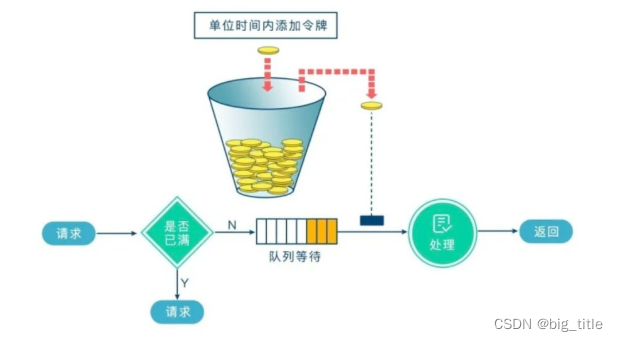问题
在开发高并发系统时有三把利器用来保护系统:缓存、降级和限流。限流可以认为服务降级的一种,限流通过限制请求的流量以达到保护系统的目的。
一般来说,系统的吞吐量是可以计算出一个阈值的,为了保证系统的稳定运行,一旦达到这个阈值,就需要限制流量并采取一些措施以完成限制流量的目的。比如:延迟处理,拒绝处理,或者部分拒绝处理等等。否则,很容易导致服务器的宕机。
常用的接口限流
计数器限流
计数器限流算法是最为简单粗暴的解决方案,主要用来限制总并发数,比如数据库连接池大小、线程池大小、接口访问并发数等都是使用计数器算法。
如:使用 AomicInteger 来进行统计当前正在并发执行的次数,如果超过域值就直接拒绝请求,提示系统繁忙。
漏桶算法
漏桶算法思路很简单,我们把水比作是 请求,漏桶比作是 系统处理能力极限,水先进入到漏桶里,漏桶里的水按一定速率流出,当流出的速率小于流入的速率时,由于漏桶容量有限,后续进入的水直接溢出(拒绝请求),以此实现限流。

令牌桶算法
令牌桶算法的原理也比较简单,我们可以理解成医院的挂号看病,只有拿到号以后才可以进行诊病。
系统会维护一个令牌(token)桶,以一个恒定的速度往桶里放入令牌(token),这时如果有请求进来想要被处理,则需要先从桶里获取一个令牌(token),当桶里没有令牌(token)可取时,则该请求将被拒绝服务。令牌桶算法通过控制桶的容量、发放令牌的速率,来达到对请求的限制。

实践
单机模式
我们这里用到了Google 开源工具包 Guava 提供了限流工具类 RateLimiter,该类基于令牌桶算法实现流量限制,使用十分方便,而且十分高效
引入依赖:
<dependency>
<groupId>com.google.guava</groupId>
<artifactId>guava</artifactId>
<version>30.1-jre</version>
</dependency>
创建注解Limit:
import java.lang.annotation.*;
import java.util.concurrent.TimeUnit;
@Retention(RetentionPolicy.RUNTIME)
@Target({ElementType.METHOD})
@Documented
public @interface Limit {
// 资源key
String key() default "";
// 最多访问次数
double permitsPerSecond();
// 时间
long timeout();
// 时间类型
TimeUnit timeunit() default TimeUnit.MILLISECONDS;
// 提示信息
String msg() default "系统繁忙,请稍后再试";
}
aop实现
import com.example.demo.common.annotation.Limit;
import com.example.demo.common.dto.R;
import com.example.demo.common.exception.LimitException;
import com.google.common.collect.Maps;
import com.google.common.util.concurrent.RateLimiter;
import lombok.extern.slf4j.Slf4j;
import org.aspectj.lang.ProceedingJoinPoint;
import org.aspectj.lang.annotation.Around;
import org.aspectj.lang.annotation.Aspect;
import org.aspectj.lang.reflect.MethodSignature;
import org.springframework.stereotype.Component;
import java.lang.reflect.Method;
import java.util.Map;
@Slf4j
@Aspect
@Component
public class LimitAspect {
private final Map<String, RateLimiter> limitMap = Maps.newConcurrentMap();
@Around("@annotation(com.example.demo.common.annotation.Limit)")
public Object around(ProceedingJoinPoint pjp) throws Throwable {
MethodSignature signature = (MethodSignature)pjp.getSignature();
Method method = signature.getMethod();
//拿limit的注解
Limit limit = method.getAnnotation(Limit.class);
if (limit != null) {
//key作用:不同的接口,不同的流量控制
String key=limit.key();
RateLimiter rateLimiter;
//验证缓存是否有命中key
if (!limitMap.containsKey(key)) {
// 创建令牌桶
rateLimiter = RateLimiter.create(limit.permitsPerSecond());
limitMap.put(key, rateLimiter);
log.info("新建了令牌桶={},容量={}",key,limit.permitsPerSecond());
}
rateLimiter = limitMap.get(key);
// 拿令牌
boolean acquire = rateLimiter.tryAcquire(limit.timeout(), limit.timeunit());
// 拿不到命令,直接返回异常提示
if (!acquire) {
log.debug("令牌桶={},获取令牌失败",key);
throw new LimitException(limit.msg());
}
}
return pjp.proceed();
}
}
使用:
permitsPerSecond 代表请求总数量
timeout 代表限制时间
即 timeout 时间内,只允许有 permitsPerSecond 个请求总数量访问,超过的将被限制不能访问
import com.example.demo.common.annotation.Limit;
import com.example.demo.common.dto.R;
import lombok.extern.slf4j.Slf4j;
import org.springframework.web.bind.annotation.GetMapping;
import org.springframework.web.bind.annotation.RestController;
import java.util.ArrayList;
import java.util.List;
@Slf4j
@RestController
public class TestController {
@Limit(key = "cachingTest", permitsPerSecond = 1, timeout = 500, msg = "当前排队人数较多,请稍后再试!")
@GetMapping("cachingTest")
public R cachingTest(){
log.info("------读取本地------");
List<String> list = new ArrayList<>();
list.add("蜡笔小新");
list.add("哆啦A梦");
list.add("四驱兄弟");
return R.ok(list);
}
}
启动项目测试:
快速刷新访问或者用工具测试
在输出中我们可以看到访问已经有被成功限制
该种方式属于应用级限流,假设将应用部署到多台机器,应用级限流方式只是单应用内的请求限流,不能进行全局限流。因此我们需要分布式限流和接入层限流来解决这个问题。
分布式
- 基于 redis + lua 脚本的分布式限流
分布式限流最关键的是要将限流服务做成原子化,而解决方案可以使用 redis+lua 或者 nginx+lua 技术进行实现,通过这两种技术可以实现的高并发和高性能。
首先我们来使用 redis+lua 实现时间窗内某个接口的请求数限流,实现了该功能后可以改造为限流总并发/请求数和限制总资源数。lua 本身就是一种编程语言,也可以使用它实现复杂的令牌桶或漏桶算法。 因操作是在一个 lua 脚本中(相当于原子操作),又因 redis 是单线程模型,因此是线程安全的。
相比 redis 事务来说,lua 脚本有以下优点:
- 减少网络开销:不使用 lua 的代码需要向 redis 发送多次请求,而脚本只需一次即可,减少网络传输;
- 原子操作:redis 将整个脚本作为一个原子执行,无需担心并发,也就无需事务;
- 复用:脚本会永久保存 redis 中,其他客户端可继续使用。
这里我们也是用到注解形式,创建RedisLimit
import com.example.demo.common.enums.LimitType;
import java.lang.annotation.*;
@Target({ElementType.METHOD,ElementType.TYPE})
@Retention(RetentionPolicy.RUNTIME)
@Inherited
@Documented
public @interface RedisLimit {
// 资源名称
String name() default "";
// 资源key
String key() default "";
// 前缀
String prefix() default "";
// 时间
int period();
// 最多访问次数
int count();
// 类型
LimitType limitType() default LimitType.CUSTOMER;
// 提示信息
String msg() default "系统繁忙,请稍后再试";
}
aop实现
import com.example.demo.common.annotation.RedisLimit;
import com.example.demo.common.enums.LimitType;
import com.example.demo.common.exception.LimitException;
import com.google.common.collect.ImmutableList;
import lombok.extern.slf4j.Slf4j;
import org.apache.commons.lang3.StringUtils;
import org.aspectj.lang.ProceedingJoinPoint;
import org.aspectj.lang.annotation.Around;
import org.aspectj.lang.annotation.Aspect;
import org.aspectj.lang.reflect.MethodSignature;
import org.springframework.context.annotation.Configuration;
import org.springframework.data.redis.core.RedisTemplate;
import org.springframework.data.redis.core.script.DefaultRedisScript;
import org.springframework.web.context.request.RequestContextHolder;
import org.springframework.web.context.request.ServletRequestAttributes;
import javax.servlet.http.HttpServletRequest;
import java.lang.reflect.Method;
import java.util.Objects;
@Slf4j
@Aspect
@Configuration
public class RedisLimitAspect {
private final RedisTemplate<String, Object> redisTemplate;
public RedisLimitAspect(RedisTemplate<String, Object> redisTemplate) {
this.redisTemplate = redisTemplate;
}
@Around("@annotation(com.example.demo.common.annotation.RedisLimit)")
public Object around(ProceedingJoinPoint pjp){
MethodSignature methodSignature = (MethodSignature)pjp.getSignature();
Method method = methodSignature.getMethod();
RedisLimit annotation = method.getAnnotation(RedisLimit.class);
LimitType limitType = annotation.limitType();
String name = annotation.name();
String key;
int period = annotation.period();
int count = annotation.count();
switch (limitType){
case IP:
key = getIpAddress();
break;
case CUSTOMER:
key = annotation.key();
break;
default:
key = StringUtils.upperCase(method.getName());
}
ImmutableList<String> keys = ImmutableList.of(StringUtils.join(annotation.prefix(), key));
try {
String luaScript = buildLuaScript();
DefaultRedisScript<Number> redisScript = new DefaultRedisScript<>(luaScript, Number.class);
Number number = redisTemplate.execute(redisScript, keys, count, period);
log.info("Access try count is {} for name = {} and key = {}", number, name, key);
if(number != null && number.intValue() == 1){
return pjp.proceed();
}
throw new LimitException(annotation.msg());
}catch (Throwable e){
if(e instanceof LimitException){
log.debug("令牌桶={},获取令牌失败",key);
throw new LimitException(e.getLocalizedMessage());
}
e.printStackTrace();
throw new RuntimeException("服务器异常");
}
}
public String buildLuaScript(){
return "redis.replicate_commands(); local listLen,time" +
"\nlistLen = redis.call('LLEN', KEYS[1])" +
// 不超过最大值,则直接写入时间
"\nif listLen and tonumber(listLen) < tonumber(ARGV[1]) then" +
"\nlocal a = redis.call('TIME');" +
"\nredis.call('LPUSH', KEYS[1], a[1]*1000000+a[2])" +
"\nelse" +
// 取出现存的最早的那个时间,和当前时间比较,看是小于时间间隔
"\ntime = redis.call('LINDEX', KEYS[1], -1)" +
"\nlocal a = redis.call('TIME');" +
"\nif a[1]*1000000+a[2] - time < tonumber(ARGV[2])*1000000 then" +
// 访问频率超过了限制,返回0表示失败
"\nreturn 0;" +
"\nelse" +
"\nredis.call('LPUSH', KEYS[1], a[1]*1000000+a[2])" +
"\nredis.call('LTRIM', KEYS[1], 0, tonumber(ARGV[1])-1)" +
"\nend" +
"\nend" +
"\nreturn 1;";
}
public String getIpAddress(){
HttpServletRequest request = ((ServletRequestAttributes) Objects.requireNonNull(RequestContextHolder.getRequestAttributes())).getRequest();
String ip = request.getHeader("x-forwarded-for");
if(ip == null || ip.length() == 0 || "unknown".equalsIgnoreCase(ip)){
ip = request.getHeader("Proxy-Client-IP");
}
if(ip == null || ip.length() == 0 || "unknown".equalsIgnoreCase(ip)){
ip = request.getHeader("WL-Client-IP");
}
if(ip == null || ip.length() == 0 || "unknown".equalsIgnoreCase(ip)){
ip = request.getRemoteAddr();
}
return ip;
}
}
使用:
count 代表请求总数量
period 代表限制时间
即 period 时间内,只允许有 count 个请求总数量访问,超过的将被限制不能访问
import com.example.demo.common.annotation.Limit;
import com.example.demo.common.annotation.RedisLimit;
import com.example.demo.common.dto.R;
import lombok.extern.slf4j.Slf4j;
import org.springframework.web.bind.annotation.GetMapping;
import org.springframework.web.bind.annotation.RestController;
import java.util.ArrayList;
import java.util.List;
@Slf4j
@RestController
public class TestController {
@RedisLimit(key = "cachingTest", count = 2, period = 2, msg = "当前排队人数较多,请稍后再试!")
// @Limit(key = "cachingTest", permitsPerSecond = 1, timeout = 500, msg = "当前排队人数较多,请稍后再试!")
@GetMapping("cachingTest")
public R cachingTest(){
log.info("------读取本地------");
List<String> list = new ArrayList<>();
list.add("蜡笔小新");
list.add("哆啦A梦");
list.add("四驱兄弟");
return R.ok(list);
}
}
如上测试方法,可以检测出被限制的访问




















 428
428











 被折叠的 条评论
为什么被折叠?
被折叠的 条评论
为什么被折叠?








